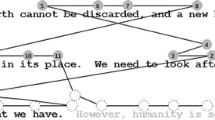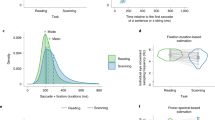Abstract
The individual characteristics of macrosaccades during the reading of fairy tales were measured, and the ability of subjects (students of liberal arts colleges) to demonstrate the understanding of the text (moral of tales) by writing a short summary was assessed. The abstracts were estimated by independent experts using a six-point scale. The preparation of the summary was not limited in time. Any relationship between the reading speed and the quality of text interpretation was not found. No relationship between the under-standing of the hidden moral and the number of characters captured in one fixation and the mean duration of macrosaccade was found either. Correlation analysis showed an inverse relationship between the number of returns and the understanding of the text: the grater the number of return macrosaccades, the worse the understanding of the text. An inverse relationship between the number of captured characters and the number of macrosaccades was found. The reading time of the text is directly correlated with the number of fixations. This means that the bandwidth of the visual communication channel per unit time is determined by the number of captured characters. The smaller the number of characters captured during fixation, the greater the reading time and the smaller the bandwidth of the eye per unit time.
Similar content being viewed by others
References
Lebedeva, I.S., Creative and practical importance of tasks in teaching reading to students of technical colleges, in Vysshee gumanitarnoe obrazovanie XXI veka: Problemy i perspektivy: Matly pyatoi mezhdun. nauch.-prakt. konf (Higher Liberal Arts Education in XXI Century: Problems and Prospects, Proc. Fifth Int. Sci.-Pract. Conf.), Samara: PGSGA, 2010.
Radina, N.K., Istorii i skazki v psikhologicheskoi praktike (Stories and Fairy Tales in Psychological Practice), St. Petersburg, 2006.
Just, M.A. and Carpenter, R.A., A theory of reading: from eye fixations to comprehension, Psychol. Rev., 1980, vol. 87, p. 329.
Filin, V.A., Avtomatiya sakkad (Automaticity of Saccades), Moscow: Izd. MGU, 2002.
Vakhrameeva, O.A., Sukhinin, M.V., Moiseenko, G.A., Murav’eva, S.V., Pronin, S.V., Volkov, V.V., and Shelepin, Yu.E., The study of perception thresholds depending on the geometry of the fovea, Sensor. Sistemy, 2013, vol. 27, no. 2, p. 122.
Yarbus, A.L., Rol’ dvizhenii glaz v protsesse zreniya (The Role of Eye Movements in Vision), Moscow: Nauka, 1965.
Rayner, K., Movements in reading and information processing: 20 years of research, Psychol. Bull., 1998, vol. 124, no. 3, p. 372.
Ishida, T. and Ikeda, M., Temporal properties of information extraction in reading studied by a text-mask replacement technique, J. Opt. Soc. A: Optics lmage Sci., 1989, vol. 6, p. 1624.
Rayner, K., Eye movements, perceptual span, and reading disability, Ann. Dyslexia, 1983, vol. 33, p. 163.
Slowiaczek, M.L. and Rayner, K., Sequential masking during eye fixations in reading, Bull. Psychonom. Soc., 1987, vol. 25, p. 175.
Rayner, K., Visual Selection in Reading, Picture Perception, and Visual Search: A Tutorial Review. Attention and Performance, Hillsdale, NJ: Erlbaum, 1984, p. 10.
Huey, E.B., The Psychology and Pedagogy of Reading, Cambridge, MA: MIT, (Originally published 1908) 1968.
Taylor, E.A., Controlled Reading: A Correlation of Diagnostic, Teaching and Corrective Techniques, Chicago: University of Chicago Press, 1937.
Kempbell, F.V. and Shelepin, Yu.E., Foveola capabilities in distinguishing objects, Sensor. Sistemy, 1990, vol. 4, no. 2, p. 181.
Magnusson, E. and Naucler, K., Reading and spelling in language disordered children—linguistic and meta-linguistic prerequisites: report on a longitudinal study, Clin. Linguist. Phonet., 1990, vol. 4, p. 49.
Bouma, H., Visual Search and Reading: Eye Movements and Functional Visual Field: A Tutorial Review. Attention and Performance, Hillsdale, NJ: Erlbaum, 1978, p. 7.
Currie, C., McConkie, G.W., Carlson-Radvansky, L.A., and Irwin, D.E., The role of the saccade target object in the perception of a visually stable world, Percept. Psychophys., 2000, vol. 62, p. 673.
Barabanshchikov, V.A., Dinamika zritel’nogo vospriyatiya (Visual Perception Dynamics), Moscow: Nauka, 1990.
Rayner, K and Sereno, S.S., Eye movements in reading: psycholinguistic studies, in Handbook of Psycholinguistics, New York: Academic Press, 1994.
Gippenreiter, Yu.B., Dvizheniya chelovecheskogo glaza (Human Eye Movements), Moscow: Izd. MGU, 1978.
Carpenter, P.A. and Just, M.A., What your eyes do while your mind is reading, in EYe Movements in Reading: Perceptual and Language Processes, New York: Academic Press, 1983, p. 275.
Rayner, K. and Duffy, S.A., On-line comprehension processes and eye movements in reading, in Reading Research: Advances in Theory and Practice, New York: Academic Press, 1988, p. 13.
Rayner, K. and McConkie, G.W., What guides a reader’s eye movements, Vision Res., 1976, vol. 16, p. 829.
Abrams, S.G. and Zuber, B.L., Some temporal characteristics of information processing during reading, Reading Res. Quarterl., 1972, vol. 12, p. 41.
Rayner, K., Parafoveal identification during a fixation in reading, Acta Psychologica, 1975, vol. 39, p. 272.
Golikov, Yu.Ya. and Kostin, A.N., Theory and methods of problematicity analysis in a complex operator activity, in Problemnost’ v professional’noi deyatel’nosti: teoriya i metody psikhologicheskogo analiza (Problematicity in Professional Activity: Theory and Methods of Psychological Analysis), Moscow: Institut psikhologii RAN.
Author information
Authors and Affiliations
Corresponding author
Additional information
Original Russian Text © A.M. Lamminpiya, O.V. Zaschirinskaia, Yu.E. Shelepin, 2015, published in Fiziologiya Cheloveka, 2015, Vol. 41, No. 2, pp. 23–28.
Rights and permissions
About this article
Cite this article
Lamminpiya, A.M., Zaschirinskaia, O.V. & Shelepin, Y.E. Psychophysiological analysis of text reading and understanding. Hum Physiol 41, 130–134 (2015). https://doi.org/10.1134/S0362119715020097
Received:
Published:
Issue Date:
DOI: https://doi.org/10.1134/S0362119715020097




